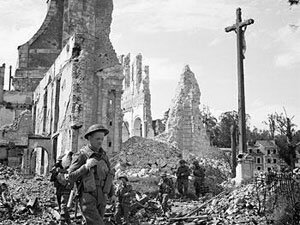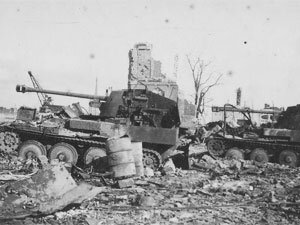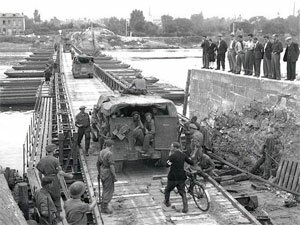The battle
The race to the Seine
The thrust of the 1st Canadian Army
From August 15, with the Polish breakthrough on the Dives, the Canadian progression on Falaise, the presence of the Americans at the gates of Argentan and the British push through the Bocage, the German front started to crack from everywhere. Those forces which have not been encircled in the Falaise pocket were retreating quickly towards east and the new defensive lines on which they expected to firmly repulse their enemies.
 August 22, 1944 - the British infantry occupies Lisieux, which is by
August 22, 1944 - the British infantry occupies Lisieux, which is by
then largely reduced to ruins. © IWM B9614
North, after two months of relative stability of the front between Caen and the Dives, 1st Corps (1st Canadian army) was launched in operation Paddle on August 20th. Airborne division Pegasus, assisted by Belgians (Piron Brigade) and Dutch (Princess Irene Brigade), attacked in direction of Dozulé and Brucourt. These three units continued to narrow the sea in direction of the Seine. On its way, the Belgian Brigade released Deauville August 23rd and arrived the following day at the doors of Honfleur, while the 6th airborne advanced the same day on Pont-Audemer. The units participating in operation Paddle, after having cleaned the area, were ready to cross the Seine.
On their right flank, Lisieux, devastated by continuous shelling, was reached on August 22nd by the 7th armoured and 51st infantry divisions. It would not be safe until evening of the 23rd, as snipers continued to harass the city. Finally, after having passed Risle river, the 7th armoured division will reach the Seine on August 28th.
More to the South, 2nd Canadian Corps crossed the Auge country through Vimoutiers and advanced on Rouen. On their road, Canadians had to overcome several pockets of resistance in the La Londe forest, for which heavy fighting continued on August 26 and 27. The 2nd, 3rd, and the 4th Canadian Divisions crossed the Seine close to Elbeuf and reached Rouen the 30.
The second British army also drove full east. 12th Corps advanced on Louviers, but 30th Corps progressing east towards Vernon got mixed up with 19th American Corps, which was coming up from the south in direction of Elbeuf. The traffic jam which resulted from this confusion wasted an invaluable time. However, in spite of German resistance and this confusion, the 21st army group joined the Americans in Elbeuf as of August 26.
German armies cross the Seine
In spite of the fast succession of the operations in the Falaise pocket, several tens of thousands of Germans had succeeded in escaping from Lower Normandy before the jaws of allied armies have closed on them in the Chambois – Coudehard area. Others had succeeded in leaving the pocket during the fighting, through the gap opened by paratroopers and SS. Finally, with the garrisons and occupation troops, more than 200.000 soldiers were now confined on left bank of the Seine in the last days of August. These troops, harassed by the FFI and pressured by the allied advance, were now to escape east.
 August 1944 - two self-propelled guns destroyed by the bombar-
August 1944 - two self-propelled guns destroyed by the bombar-
dments on left bank of the Seine.
The capture of Mantes by the 3rd Army of Patton and the progression of the 21st Army group on the northern flank do created the risk of a new encirclement. To leave the trap before it was too late, the Germans succeeded in reorganizing a couple of defensive lines intended to slow down the allied progression:
- On the Northern flank, the remainders of the 86. Korps were opposed to the 1st British Corps. In the South, 81. Korps was to slow down the Americans.
- The center of the German organisation consisted in units crushed in the Falaise pocket but still counting some manpower.
Even if these defences were often improvised, some skilfully positioned anti-tank guns make it possible to delay for a few hours the rush of the armoured divisions.
The resistance of these rearguards allowed German engineers to arrange several crossings on the Seine. In Rouen, the Eauplet railway bridge, even damaged, allowed to evacuate tens of thousands of soldiers. In Elbeuf, another bridge was operating until the allied troops finally entered the city. In addition to three boat bridges, Germans manned several ferries - as in Caudebec - or used regular boats. Finally, about fifty crossing points allowed the evacuation.
On August 29th, the retreat was over. Of all the troops which escaped from the Falaise pocket, more than 90% succeeded in passing on the opposite bank, with the three quarters of the heavy equipment (30.000 vehicles and nearly 150 tanks). After the bloody fiasco in Chambois – Montormel area and the strategic defeat in the battle of Normandy, this escape from under the nose of their pursuers constituted an undeniable German success.
German tactical success
From the allied point of view, which reasons be advanced to justify this failure? Cynicaly, one could state that after three years of drawbacks on the Soviet front, the German army became a master in the art of retreats and evacuations. However, some important mistakes of the allied commanders contribute to explain German success.
 August 28, 1944 - the 4th Canadian AD cross the Seine at Elbeuf.
August 28, 1944 - the 4th Canadian AD cross the Seine at Elbeuf.
© ANC - PA 113662
Firstly, the power of allied aviation was missing. Time, rainy, did not favour it, but the main reason is that allied supreme command wanted to launch pursuit operations at the image of those carried out by Patton. Accordingly, a heavy bombardment campaign would have destroyed bridges and roads on which allied troops soon expected to roll, and had to be avoided.
It is also necessary to state exhaustion of the troops and improvisation on the level of the commanders:
After more than 11 weeks of continuous fighting, allied divisions were running low on their reserves – for instance, the 59th ID Staffordshire had to be dissolved immediately after the battle, its manpower being used to supplement other depleted units.
On the level of the commanders, the tactics of the battle of the Falaise pocket shows to which point all the operations had been improvised when the war of positions transformed into mobile warfare. Supreme headquarters lacked at that time reliable communication, as Montgomery and Bradley were driving their own private wars.
Obviously, it seems that the operations on the Seine were considered as a secondary issue. This lack of strategic vision will however turn out costly: hardly two weeks later, the British paratroopers engaged in Arnhem in operation Market-Garden faced 9th and 10th SS-PzD, which were resting after having been badly mauled in Normandy…
However, for the majority of the troops of IIIrd Reich, the crossing of the Seine was only a deferment. Indeed, the majority of allied units had crossed from August 28th and pursued the enemy. The example of the 1st Polish armored division can give an idea: after a few days of rest, it had resumed its race the 28th, released Blangy on September 1st, then Abbeville the 3rd. The 9th, when the pursuit phase ended, the Poles had driven 470 km in ten days! Another example, Kurt Meyer, âme damnée of the Canadians, who had succeeded in escaping through the Polish lines on Montormel, was captured in Belgium the 6th.













 www.evl.pl
www.evl.pl